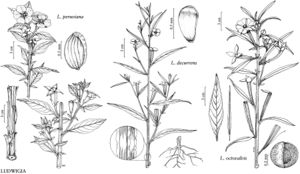Ludwigia decurrens
Fl. Carol., 89. 1788.
Herbs annual or short-lived perennial, roots and lower stem sometimes inflated and spongy. Stems erect or strongly ascending, sharply 4-angled and 4-winged, 30–200 cm, simple to densely branched, glabrous. Leaves: stipules deltate, 0.4–0.5 × 0.2 mm; sessile and continuous with wings on stem; blade lanceolate or narrowly lanceolate to narrowly ovate or elliptic, 2–20 × 0.2–5 cm, base acute or rounded, margins entire, often minutely scabrid, apex acute or acuminate, membranous, surfaces glabrous or sometimes minutely puberulent on abaxial veins; bracts linear, mostly reduced. Inflorescences open, leafy racemes, flowers solitary in distal axils; bracteoles deciduous, usually attached near base of ovary, without subtending glands, lanceolate to subovate, 0.5–1 × 0.2–0.5 mm, apex acute. Flowers: sepals ovate to lanceolate, 7–12 × 1.5–4 mm, apex acute or short acuminate, membranous, margins usually minutely scabrid, surfaces usually glabrous, sometimes puberulent abaxially; petals orbiculate-obovate, 10–20 × 10–18 mm, short-clawed; stamens 8 in 2 subequal series, yellow, filaments 1.3–2.5 mm, anthers oblong, 1.3–1.6 × 0.5–0.6 mm; ovary obconic, sharply 4-angled and 4-winged, 6–10 × 2–4.5 mm, glabrous or minutely puberulent; nectary disc plane on ovary apex, 3–5 mm diam., 4-lobed, glabrate or ringed with short hairs; style 2.5–3.2 × 0.5–0.6 mm, stigma globose, 1–2 × 1–2 mm, not exserted beyond anthers and pollen shed directly on it. Capsules rarely sharply curved, subclavate to oblong-obovoid or narrowly obpyramidal, sharply 4-angled and 4-winged, 10–25 × 3–5 mm, glabrous, pedicel 2–15 mm. Seeds oblong or subcylindric, 0.5–0.6 × 0.2 mm, striate, raphe very narrow and inconspicuous. 2n = 16.
Phenology: Flowering summer–early fall.
Habitat: Moist or swampy habitats along sloughs, muddy stream banks, marshy shores of lakes and ponds, ditches, swamps.
Elevation: 0–300[–600] m.
Distribution
Ala., Ark., D.C., Fla., Ga., Ill., Ky., La., Md., Miss., Mo., N.C., Ohio, Okla., Pa., S.C., Tenn., Tex., Va., W.Va., Wis., Mexico (Campeche, Chiapas, Michoacán, Tabasco), West Indies, Bermuda, Central America, South America, introduced in Europe (France), e Asia (Japan), Africa (Cameroon), Pacific Islands (Philippines).
Discussion
Ludwigia decurrens appears to be most closely related to L. erecta, differing by having winged, not angled, capsules and larger flowers, with sepals 7–12 mm and petals 10–20 mm (in L. erecta, sepals 3–6 mm, petals 3.5–5 mm). They often grow in close proximity and may hybridize, but hybrids would be difficult to detect. Ludwigia decurrens is often self-pollinating, but larger flowers may promote outcrossing.
Ludwigia jussiaeoides Michaux is an illegitimate later homonym of L. jussiaeoides Desrousseaux and pertains here.
Selected References
None.
